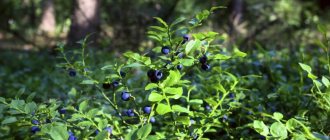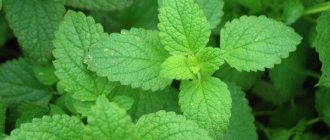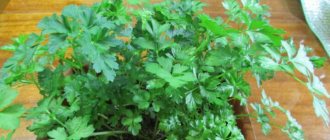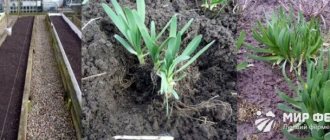Beneficial and harmful properties of blueberries
Blueberries are a storehouse of useful substances and microelements. And I say this without exaggeration, you will soon see this. Among the beneficial properties of the berry, I highlighted the following:
- The composition includes dietary fiber that is not digested in the stomach. As a result, a gel mass is formed that absorbs toxic substances from the intestinal walls and gently cleanses the entire intestinal tract.
- Stimulates the immune system, copes with infectious diseases or prevents them.
- Slows down skin aging, improves cell regeneration, protects against ultraviolet exposure.
- Consumption lowers blood sugar levels, which is why people diagnosed with diabetes use it.
- If you eat regularly, it will prevent cancer. Nowadays this is very relevant.
- Brings the nervous system back to normal, copes with stress and depression. Relieves cramps and has a slight diuretic effect.
- We started eating and put the functioning of the cardiac system in order. The berry also copes with arthritis, colitis, allergies, and restores the body after surgical intervention by doctors.
- Increases the strength of blood vessels. Forms bone, cartilage, connective tissue.
And these are not all the beneficial properties that blueberries have. I chose the ones that attract me the most. You can find a full list of useful features in the video below:
Author's note
Natalia Papanova
Blog author
One cup of blueberries provides 24% of the daily value of vitamin C and 36% of vitamin K.
If we talk about the dangers of blueberries, then I can rejoice - there is none! Occurs only if there are contraindications for use:
- urolithiasis disease;
- allergic reactions or intolerance to the product;
- pancreatic dysfunction;
- improper functioning of the liver or gall bladder.
Although blueberries have more beneficial properties than contraindications, pregnant women and small children should not eat them in large quantities. Otherwise, they will get an upset stomach, which is not very pleasant.
The same rich vitamin composition is observed in other berries. Find out how to store lingonberries at home to enjoy the delicious fruits.
Blueberries have low calorie content and can be eaten while dieting.
Optimal planting dates
The time for planting blueberries depends on the climatic conditions of the region. It should be remembered that blueberries love cool weather, so in regions with a warm climate it is better to plant them in September-October, when the weather remains comfortable, warm and humid. In the spring, hot days quickly set in in the south; blueberries may not take root and will die. When planting in autumn, before frost sets in, the plants will have time to adapt to their new location.
Healthy blueberry bushes quickly adapt to new conditions and soon begin to bear fruit
Planting blueberries in spring
The best time to plant blueberries in the central and northern regions is late spring, when the threat of returning cold weather has passed. Over the summer months, the plants will get stronger and prepare for winter. When planting in autumn, there is a high risk of shrub death, since autumn nights here can be very cold, and early frosts are not uncommon. At first, blueberries should be shaded with spunbond so that the bright spring sun does not damage the young plantings.
Blueberry varieties for growing on a windowsill
I hope that the beneficial properties of the berry convinced you that you need to eat it. Now all that remains is to plant blueberries in the apartment and grow them until the fruits are harvested. But until this moment, decide on the variety. Oh, this was a difficult task for me! There are many options to choose from, I would even say too many. I chose the “Forest Pearl” variety. For others I made a comparative description. It makes it easier to navigate this diversity.
| Name | Characteristic | Bush height | Advantages | Flaws |
| Top Hut | It is a hybrid of high bush blueberries and low growing blueberries. The foliage is small, with a bronze tint. Gives up to 1.5 kg of harvest from one bush. | up to 40 cm. | Blooms and bears fruit profusely. The root system develops quickly. Tolerates low temperatures (survives even at -40 degrees). | The berries are small, medium in size. The plant is demanding on the soil: it grows poorly and develops in an unsuitable environment. |
| Forest Pearl | Low growing shrub with dark green leaves. It can grow up to 1 m wide. In autumn, the color of the foliage changes to bright red. Berry weight - up to 4 g | 30-40 cm. | Quite large berries, not demanding in terms of care. The main thing is to moisturize and feed on time. Resistant to diseases and pests. Tolerates low temperatures well. | Does not like strongly lit places. The best place is partial shade. |
| Sunshine Blue | Among other varieties, it stretches upward more than others. It bears fruit actively and a lot: you can collect up to 2 kg of fruit from one adult bush. | up to 60 cm. | It is unpretentious to growing conditions and does not require care. The berries are large. | Fruiting begins only after 2 years. It's a long wait, I agree. |
| Black Pearl | The color of the berry is deep blue, with dark reflections. The shape is round. The bush does not reach a large size in height. The crown is formed by a “cap”. | up to 30 cm. | A miniature bush, which is important when growing at home. It is not demanding in terms of care and tolerates changes in climate and environment well. | There is low immunity and resistance to pests and diseases (especially fungal ones). It is necessary to take preventive measures regularly. |
| Dark night | The berries reach 8-12 mm in diameter. The plant loves shady places, so it is suitable for landscaping the dark side of the house. | from 20 to 40 cm. | Easy to cut: you can shape any shape. Blooms and bears fruit in large quantities. | Blueberries are demanding in terms of care: they do not tolerate moist soil, direct sunlight and changes in temperature. |
| Keen Eye | The branches are smooth with a silvery tint, the foliage is light green and round. The size of the berries is from 6 to 10 mm. Flowering duration is from 2 to 4 weeks. | up to 40 cm. | Starts to bloom early. In the first 3-4 years the bush does not shed its leaves. Develops well in a new place and quickly adapts to changing conditions. | Not available in all stores. Weak immunity is noted. |
Do you like sweeter berries than blueberries? Find out how to grow raspberries at home. The fruits are tasty and the plant is unpretentious.
The fruits of the Forest Pearl are large compared to others
Short description
Blueberry (common, myrtle-leaved) is a shrub with strong branching of small height - no more than a few decimeters (0.1-0.5 m). Belongs to the Vereskov family.
The leaves are small, pointed at the top.
Flowering occurs in May, the flowers are white with a green tint. The root system is developed, characterized by creeping growth to the sides, which subsequently produces many young shoots. Useful information: Differences between blueberries and blueberries
The ripening time of fruits - berries - depends on the climatic zone where the crop grows. In the regions of the country, this period begins in July and lasts until September. The berries are dark blue or black. A waxy coating may form, which is easily washed off with water. The pulp is purple, the number of seeds can reach 40 pieces.
Related article:
Rejuvenating currant bushes
Natural habitats are coniferous, mixed forests or swamps in the northern part of Asia and Europe.
A pine forest heavily overgrown with shrubs is called a blueberry pine forest. This growth in the neighborhood is explained by the general preferences of crops - high groundwater levels and acidic soil.
How to plant blueberries in an apartment
Once you’ve chosen a variety, it’s time to move on to the next stage. Growing blueberries on a windowsill is not difficult. The main thing is to follow the nuances of planting and know what such a plant requires. So no need to worry, get down to business right away.
Don't want to plant blueberries? Then grow currants at home. A good alternative that won't disappoint you.
Have you tried growing blueberries at home?
Not really
Where to get planting material
And so, a common question is where to get planting material. Firstly, I note that there are two ways to obtain a bush - from cuttings or from seeds. In the first case, you will find the process in the following places:
- in the nursery;
- at the garden market;
- ask your neighbor or dig it up in the forest (why not try).
To learn how and where blueberries grow in the forest, watch the video:
The seeds are collected independently from berries or purchased ready-made in the store. In the latter case, everything is simple, just decide on the variety. Well, secondly, the planting material is prepared before use. It is useless to shove it straight into the ground.
How to prepare
To collect the seeds, choose only large and ripe berries. Preparation includes:
- Select the fruits: discard spoiled, unripe or dry ones.
- Mash in a container (use anything, even your hands, if you feel comfortable). Fill with clean water.
- After 5-10 minutes, the seeds will sink to the bottom, and all the pulp and peel will float to the surface. Carefully drain the liquid, not allowing the seeds to escape.
- Repeat the washing procedure until the water in the container with the planting material is clean.
- Remove the seeds and place them on newspaper to dry naturally.
Author's note
Natalia Papanova
Blog author
Prepare a lot of planting material, since most of it will die during cultivation.
You can also grow hawthorn from seeds at home. No less tasty and healthy berry.
Preparing the soil for planting
Blueberries are picky when it comes to soil. If she doesn’t like something, she will start to get sick, will grow, develop, and bear fruit poorly. I came up with the composition for myself:
- soil from the garden (no garden - bring a bucket from the park or other accessible area);
- peat crumb;
- rotted oak leaves;
- river sand;
- powdered sulfur.
To prepare, mix the ingredients in the following proportion: 2 parts garden soil, 1 part all other ingredients. Add powdered sulfur at the rate of 3-5 g per bucket of mixture (or 1 tsp per bucket, but without a slide!).
Also, buy ready-made soil. Sometimes I do this. In this case, I use BonaForte soil. Sold in 20 liter packs.
For blueberries, the acidity of the soil should be high - pH from 4.0
When is the best time to plant
It is better to plant blueberries at home in the autumn - in the spring you will get strong, grown bushes. But since it is easy to create the necessary conditions at home for seed germination, the process can be carried out in another season at your discretion.
How to choose a container
The germination container should not be large so that the seed does not rot. I planted them in pots that were 6 cm in height and width. And then I transplanted them into a larger container. And then I had to choose more, since in this pot the plant will live for a long time.
In the end, I can say that the material is not important. You can use plastic, wood, and clay. I chose the latter. Since clay containers absorb excess moisture (if any) and release it back without any problems. The size depends on the bush. In my opinion, the optimal and best-running size is 30 cm in diameter.
How to care for seedlings
Immediately after planting, moisten the soil and cover with polyethylene or glass to create a greenhouse effect. Ventilate for 15-20 minutes every day, gradually increasing the duration. After 2-3 weeks, shoots will appear. You don't need to put a lot of effort into them. Remove the material used to create the greenhouse conditions and regularly spray the soil with water from a spray bottle.
Author's note
Natalia Papanova
Blog author
Blueberry seedlings grow slowly, so be patient and don't expect a quick jump.
Advantages and disadvantages of growing from seeds
Garden blueberries are easy to grow from seeds; you can even use frozen berries. Of course, this is a complicated matter, but fruit-bearing bushes will certainly delight gardeners.
Planting blueberries with seeds has a number of advantages:
- you can use the seeds of frozen blueberries purchased at the supermarket;
- American varieties of tall blueberries, the seeds of which can be purchased from us, practically do not get sick and are not attacked by pests;
- garden varieties grown from seeds give a good harvest and do not differ in chemical composition from their “wild” relatives.
The disadvantages of such reproduction are:
- if the seeds are taken from a wild berry, they will not take root in the garden plot;
- even with good care, the seeds do not germinate quickly and grow slowly;
- planted in open ground in the second year after germination.
For good growth, the bushes need light acidic soil, this is a prerequisite, otherwise the plantings will not take root.
Caring for homemade blueberries
Now the seedlings cease to be seedlings and a full-fledged bush begins to form. And immediately panic - what to do next. I don’t know how it was with you (it was or will be), but for me everything went like this. Because I understood that at this stage it was time to change the system of care. And indeed it is. But it didn’t matter, I changed it, and the blueberries continued to grow.
Indoor nightshade requires approximately the same care.
How to water and when
One of the important points is watering. Water the plant not often, but generously. In hot periods 3-4 times a month, and in winter 1 time every 1-1.5 months. Depending on its size, it took from 500 ml to 1 liter per specimen.
To check whether blueberries need watering, look at the top layer of soil. It should be moist about 15-20 cm deep, but not soggy
. Excess water, like too little, will not lead to anything good.
If you don’t want to plant berries in your apartment, replace them with exotic fruits. For example, grow persimmons at home. The fruits of the tree will delight you every year.
If there is not enough moisture, the leaves will begin to turn yellow and the berries will fall off.
Necessary feeding
Blueberries do not react very positively to the application of organic fertilizers. Therefore, it is better to exclude them from plant care. For feeding, it is enough to apply complex mineral fertilizers once a year (I recommend in the spring). I used such as “Ammofoska”, “Diammonium phosphate” and “Nitroammophos”. The rest of the time, it is enough to change the top layer of soil by adding peat, a mixture of sawdust and pine needles (4-5 cm thick).
To learn about what complex fertilizers you can use in the fall, see the following video below:
Harvesting
Blueberries begin to be picked in mid-June. And they continue cleaning until the beginning of September. Berries are harvested every 5-10 days in several approaches. The berries that are to be harvested are blue-violet and black. They will become ripe 7-8 days after they change color. These are the berries that are the most juicy, sweet and aromatic.
To avoid injury to the crop during harvesting, do not tear it off, but turn it a little, grasping it with your thumb and forefinger. Harvested berries without mechanical damage or signs of disease at zero temperatures last for about 1.5 months. To preserve the freshness of fruits even longer (not in the form of jams and compotes and without the help of a freezer), there is another proven storage method:
- Take a glass jar, which is kept in the oven for several hours at a temperature of 200 °C.
- The berry crop, thoroughly cleaned of various debris and leaves, is poured into it.
- Then the containers are sealed with corks and filled with wax.
- Blueberries are stored in a dark, cool room.
Due to uneven ripening, the fruiting period is greatly extended in time.
How to properly propagate indoor blueberries
If you already have a healthy and mature blueberry bush, you can get other specimens from it. To increase my home harvest, I did just that, I was pleased with the result, so I will be happy to share my experience with you.
Propagation by cuttings
Propagation by cuttings takes place in the following sequence:
- Cut the young shoots and form cuttings from them (the branches should be 5-7 cm long).
- Remove leaves from the bottom of the cutting (half or ¼ of the total length).
- Place the cutting in the diluted mixture to stimulate root formation. This could be “Kornevin”, “Kornerost” and others. Diluted in the following proportion: 1-2 g per 1 liter of water.
- Prepare the soil. To do this, mix peat and sand in equal quantities (you can replace it with sawdust). Moisten slightly.
- Make holes in the soil and stick the cuttings there. Rooting will take up to 6 weeks
.
There are no specific instructions regarding care: water regularly and make sure that the soil does not dry out. That's all. The first leaves will appear, congratulations, the cutting has taken root and you will soon have another blueberry bush.
Propagation by seeds
Blueberries take longer to reproduce from seeds. Here, first you will need to wait for it to bear fruit, then collect the seeds, germinate them, and only after about a year you will have a small bush, but a bush.
To obtain seeds, collect ripe berries, crush them and soak them in water. All the pulp will rise to the top. Remove it and rinse the planting material several more times. Dry and that’s it, your seeds are collected.
And in order not to suffer, you can buy ready-made seeds in the store
Planting a plant in a summer cottage
Blueberries are planted in open ground in mid-April or October. For tall varieties, sunny areas are suitable. Bushes dug up in the forest love shade or at least partial shade: this will make care easier in the future. The soil should be loose and acidic. Before rooting the seedlings, the soil is spilled with water containing oxalic or citric acid (at the rate of 1 tablespoon per bucket of water). An alternative is apple cider vinegar (100 ml for the same amount of water).
The distances between the holes are up to 2 m. The depth of the holes is 0.4-0.6 m, the diameter is 0.8 m. The bushes are planted with a moistened earthen ball, the roots are carefully straightened and sprinkled with a mixture of peat and soil. The holes are compacted, watered abundantly, and then mulched. Although blueberries are considered frost-resistant, if there is a threat of return frosts (during spring planting), they are covered with agrofibre at night.
Advice. The height of the seedling’s earthen coma should be about 7 cm, and the “age” of the bush should be 2-3 years.
Diseases and pests of blueberries
And now about the most unpleasant thing - diseases and pests. Although such “illnesses” rarely appear in blueberries, they do occur. Therefore, you need to prepare for them. The most common ailments are:
Stem cancer
Most often appears in early spring. Looks like sunburn spots. Subsequently, these spots grow, envelop the shoot and it dies. To combat, immediately remove all affected branches and burn. Next, treat the plant with Bordeaux mixture until new leaves appear. For 10 liters of water, add 100 ml of liquid. Spray after cooking. At the final stage, spray the bush with foundation 3 times (with an interval of a week). Dilute at a ratio of 2 g per 1 liter of water.
Gray rot
It develops and appears in rainy and humid weather. It can be recognized by the white fluffy coating that envelops both stems and leaves. As a result, blueberries begin to lag in growth, the leaves fall off, and the fruits rot. To eliminate, spray the plant with topsin. Diluted at the rate of 2 g per 1 liter. I note that fruit trees, for example, are not so afraid of gray rot. Find out in advance about the characteristics of lemon flowering at home if you are going to plant one or if you already have one.
Rust
You can’t confuse this pain with anything else. It primarily affects the leaves: brown spots appear on them, which quickly spread and grow. Start by cutting off any damaged buds, stems and foliage. Then treat with a fungicide containing copper. I used Kuproxat. I diluted it in the following proportion: 40 ml of product per 10 liters of water. After 1-2 weeks, the treatment was repeated.
Chafer
They can be recognized by their special appearance. The beetle reaches 2-3.5 cm in size. It has a chitinous shell on top that protects it. Color: red with red or black. Most often it nests on the back of a leaf. It eats greens and deprives the plant of strength and energy, which is why it quickly fades.
Glassware
It is a butterfly, but looks very much like a wasp. It has narrow wings with an orange border around the edges. When it appears, it begins to lay eggs in small cracks in the bark or near the buds. As a result, offspring appear - caterpillars that eat the blueberries. As a result, branches that seem healthy at first glance begin to wither and dry out.
To combat both pests, treat the bush with insecticides. I used Intavir. To obtain the result, 1 tablet was diluted in 0.5 water, and then sprayed. The strike disappeared quickly, and the blueberries recovered from the damage.
Pest control must be started immediately so that they do not have time to spread.
Growing conditions
To grow Blueberries, acidic soil on which vegetable crops have not previously grown is ideal. Also, such soils are perfect for growing Cranberries or Blueberries. Blueberries do not like direct sunlight, so places in the shade of trees, near a fence or next to buildings are great. Due to its lack of cultivation, the shrub is planted at some distance from vegetable and flower beds, otherwise you risk reducing their yield due to infection.
A rich harvest is possible only from bushes growing on acidic soils
Watering
Blueberries do not require frequent watering. In summer, watering is necessary no more than twice a month. If a hydrogel was used, less water is required. Excessive moisture provokes plant diseases, as a result of which it may die. If hydrogel has not been added to the soil, blueberries should be watered more often. The watering system should not be disturbed if the plant is young. It needs to develop a root system before winter in order to survive frosts. Poor watering can slow down root growth. An adult plant requires less abundant watering. It is enough to carry out the procedure of moistening the soil once a month. Large amounts of water should be avoided, as the soil around the bush collects moisture well.
Weeding and loosening
Weeding and loosening the soil is carried out more often than watering. These actions should be carried out immediately after grass appears around the bush. After weeding, extraneous plants must be removed from the site so that they cannot germinate again. The blueberry root system is close to the surface. In order not to damage the root, loosening is carried out to a maximum depth of 3 centimeters. Before loosening, it is recommended to pour a five-centimeter layer of sawdust onto the ground around the bush, and then carry out the procedure.
Top dressing
Plants require fertilizing for the first few days after planting. For blueberries, two types of fertilizing are used: root and foliar. Only liquid fertilizers are used, since the integrity and safety of the root system depends on this. For blueberries, it is recommended to use three types of fertilizer:
- nitrogen;
- phosphorus;
- complex of microelements.
This is interesting: Drainage for indoor flowers: what can be used from improvised means
The use of fertilizers reduces the acidity of the soil, which negatively affects the plant. To avoid this, the fertilizer is mixed with a solution of colloidal sulfur. The diluted substance is watered around the bush and directly under the root. The best time to fertilize is evening. The fertilizer should be diluted in water whose temperature is warmer than the air. Foliar feeding is carried out using a sprinkler. Recommendations for diluting the substance are the same as for root feeding. Fertilizer is evenly sprayed onto the bush. It is not recommended to perform the procedure during the daytime, since the leaves can get burned when exposed to sunlight. Foliar feeding protects the plant from pests. It is recommended to fertilize twice a month after each watering. Do not apply fertilizers before watering.
We form young seedlings
Blueberries are not pruned immediately after planting. Only in the 3-4th year do they begin to carry out annual pruning. At the same time, frozen, dried and damaged branches are removed. For good fruiting, an adult plant requires 6-8 strong, developed branches. Weak and underdeveloped shoots are removed. Old branches are gradually updated with new ones.
The aging of bushes immediately affects the yield, so a plant older than 15 years needs strong anti-aging pruning. It is carried out in early spring at a temperature no higher than +5 °C at a height of about 30 centimeters above ground level. The sections are carefully treated with garden varnish.
Protection from diseases and pests
If a plant is infected with a viral disease, it is dug up and burned to protect other bushes from infection. Insecticides are used to control aphids. Bordeaux mixture applied to the bush by spraying helps against scale insects. It is recommended to use fungicides against diseases. To prevent the occurrence of diseases, fallen leaves must be collected and burned. The presence of pests can be detected in winter. In spring, a sign of their appearance is a cobweb on the plant. Blueberries are a healthy plant whose fruits contain a large amount of vitamins. Having created favorable conditions, it can be grown on your own plot of land. But for this it is necessary to adhere to a number of rules for planting and care.
Do I need to cover it for the winter?
Blueberries tolerate sub-zero temperatures well. An adult plant does not need shelter. The roots of young seedlings are protected from severe frosts with a thick layer of sawdust mulch.
How to store blueberries at home
Of course, you want to preserve the harvested crop for as long as possible. After all, not everything is eaten, and not right away. I can console you, this can be done. And there are special simple ways for this.
Storage in water
For this method, the berries first undergo a preparation process:
- Rinse them under running water, remove all debris, rotten and damaged fruits.
- Prepare a solution of vinegar and water in a ratio of 1 to 3. Place the berries in the liquid for 1-2 minutes. This will kill fungal spores.
- Rinse in clean water to remove the vinegar smell. Dry blueberries naturally.
- Pack it in glass jars, fill it with cold water and put it in the refrigerator.
You can preserve watermelons at home in approximately the same way. Get acquainted with this to keep the giant berry in edible condition longer.
Author's note
Natalia Papanova
Blog author
Blueberries can be stored in this form for up to 3-4 months. For longer storage, change the water every 2-3 days.
You can find other storage methods in the video:
Storage at room temperature
At room temperature, blueberries will not last long. Maximum - 2-3 days. But to save for this period of time, follow these rules:
- make sure the berries are completely dry;
- Do not wash the entire volume in water at once. Rinse in portions and only as much as you eat at a time;
- Place the blueberries in a container with holes to allow air to flow freely.
How to store blueberries in the refrigerator
In order for blueberries to be preserved in the refrigerator, they also need to be distributed among containers. They should have holes for ventilation and not be made of metal. Otherwise, the berry will react with this metal and become discolored.
Before distributing into containers, wash and dry the fruits. Place a paper towel folded in four layers at the bottom of the container. And then throw the berries on it. Thanks to this, you will protect the crop from mold. That’s all, you can then put it in the refrigerator.
Author's note
Natalia Papanova
Blog author
Avoid placing containers in the coldest areas of the refrigerator. Too low a temperature will damage the fruit.
I also store persimmons in the refrigerator at home. Compared to blueberries, they last longer.
We prepare the soil in September, plant in October
Before you start growing blueberries at home, you need to prepare the area well. Many people mistakenly believe that this plant should be planted in the shade under trees. This is a mistake. Only sufficient lighting will allow you to get a good harvest of berries. Partial shading, clearings between trees and near a pond are suitable.
Only sufficient lighting will allow you to get a good harvest of berries.
The main requirement is constant moderate soil and air humidity.
- The soil in the country, as a rule, has weak acidity. In order for blueberries to grow and bear fruit well, this must be corrected. If we are talking about bush planting, then a hole is dug under each bush, measuring 150 by 150 cm and 60 cm deep.
- Peat crumbs are added to the excavated soil in a ratio of 2:1.
- True, natural acidity will not be enough, so it is necessary to add powdered sulfur. In this case, oak foliage and, of course, pine needles would be a good feed.
- When the soil is quite heavy, for example, clayey, then it would be useful to add sand. River water is best suited for these purposes.
It should be remembered that all these activities should be carried out in advance. Before landing, all actions will be in vain. All additives must settle in the ground. If planting is planned for October, then September will be the main month for soil preparation.
If planting is planned for October, then September will be the main month for soil preparation
How to preserve blueberries for the winter
If your plans are more ambitious—to preserve blueberries until winter—you will need other methods, which, by the way, are no less effective.
If stored properly, blueberries will not lose their beneficial properties.
Freezing ripe berries
As always, first, sort out, rinse, and then dry the fruits. Well, then proceed directly to freezing. I did it as follows.
- I spread the berries over a flat surface (in my case it was 3 cutting boards, but a baking sheet, tray or something else flat will do). I laid it out so that there was space between the fruits and they didn’t stick together.
- Placed it in the freezer for 1-1.5 hours.
- Got it. I poured the frozen “peas” into a hermetically sealed bag. put it back in the freezer.
That's it. Everything is ready. In this state, blueberries can be stored for a year or more.
Are you preparing blueberries for the winter?
Not really
Canning blueberries with sugar
You can preserve the fruits in canned form. In this regard, I use a recipe that my grandmother gave me.
Ingredients:
- water - 300 g;
- blueberries - 1 kg;
- sugar - 1.5 kg.
Canning sequence:
- Sort through the berries, leaving only whole ones without damage. Rinse in cold water.
- Place in boiling water for 1 minute. Then drain all the liquid. Then pour in clean liquid (300 g) and place on low heat.
- After boiling, add sugar. Stir until all crystals dissolve. Boil for 15-20 minutes. Skim off any foam that forms on top as you go.
- Using a slotted spoon, pack the blueberries into pre-sterilized jars. Strain the syrup through three-layer cheesecloth and pour into jars. Close the lid.
The canned blueberries are ready, you can put them in a cool place for storage. Shelf life: from 6 months. Calorie content per 100 g - 69 Kcal.
How to dry blueberries
For this method you can use the following:
- Fresh air. The weather should be dry, sunny and warm. Place the berries in a place where there is no direct sunlight (this will preserve more vitamins). Leave in this state for 6-10 days. During this time, the fruits will reach the desired condition.
- Oven. Start drying in the oven at 40-50 degrees. Once the berries have dried, increase to 70.
- In an electric dryer. Here follow the instructions that came with your unit.
Dried berries can be stored for a year or more.
Dried blueberries look like raisins
Underground
You can store berries in a cellar buried in the ground. In this case, it is important to prepare the room itself: it should be dry, dark, free of mold and fungal damage. It is best to place the berries in wooden containers with holes, and then send them to the cellar in this form.
FAQ
Natalia Papanova
Blog author
Ask your question
Blueberries are a berry with which I do not communicate on a first-name basis. So in the process of storing it, I had some questions that caused confusion. To prevent this from happening to you, I will share the answers.
How long can blueberries be stored at home?
Depending on the storage method, blueberries can last at home from 2-3 weeks to a year.
How long will it take for blueberries to bloom at home?
Depending on the variety and growing conditions, blueberries will bloom in the first or second year of life.
How long do unripe blueberries last?
Unripe blueberries are stored 1-1.5 months longer than ripe ones.
How to ripen blueberries?
To ripen, place the berries in soft paper (even newspaper will do) and leave at room temperature. To speed up the process, place a ripe pear or apple there. After 2-3 days, the fruits will reach the desired state.
Blueberry propagation
The summer resident always has blueberry seed material at hand - he just needs to extract the seeds from the berry, but summer residents more often propagate the plant by cuttings and dividing the bushes. This is much easier than germinating seeds, and blueberries will begin to bear fruit earlier.
Cuttings
An entire blueberry plantation can be propagated in this way:
- The tops of healthy, non-lignified green branches are cut off to a length of 15–18 cm, and 2–3 growth buds are retained. A cut from below is made at 45° and excess leaves are cut off. The upper one is at a right angle, at a distance of 2 cm above the kidney.
- The cuttings are planted at an angle and rooted in peat with a “baking powder” (perlite, coconut fiber, sand). To speed up the establishment, sprinkle with a root stimulant.
- Moisten thoroughly and cover with plastic containers. This retains the necessary heat and provides lighting.
The roots of cuttings cut in the second half of July form quickly. In October, the plants are assigned to a permanent place. If the weather is not suitable, the cuttings are buried in boxes with sand for the winter and stored at zero temperature.
Seeds
To obtain planting material, ripe berries are crushed and filled with water. Empty seeds immediately float to the surface. Repeat the procedure until the water is clear. The seeds are dried and planted in a bowl with peat. The first shoots will appear within a month if watering is regular. Wintering is organized in a cool room (not higher than 10°C). In spring the plants peak. It can be planted only after a year. The harvest of blueberries obtained from seeds can take up to 6 years.
Dividing the bush
In autumn, the crop is propagated traditionally. They dig up an adult plant, divide it into parts and plant it like three-year-old plants. Everything must be done carefully in order to preserve the roots as much as possible, because they are located close to the surface. It is important to ensure that the planting bushes have at least 5 healthy buds.











